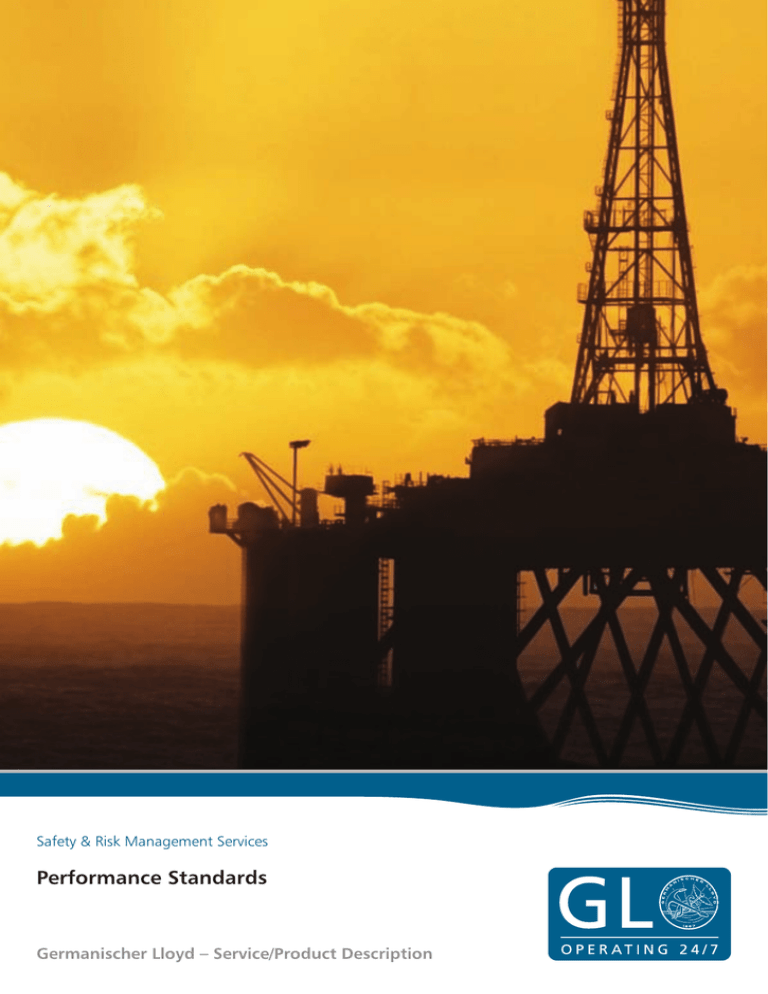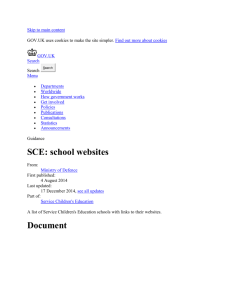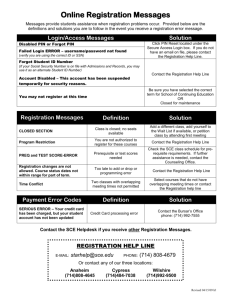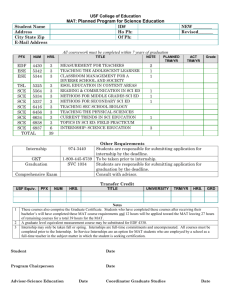Performance Standards Germanischer Lloyd – Service/Product Description Safety & Risk Management Services
advertisement

Safety & Risk Management Services Performance Standards Germanischer Lloyd – Service/Product Description Germanischer Lloyd – Service/Product Description Performance Standards Contents Service Title: Safety & Risk Management Services Page 3 Service Description and Values Generated Lead Practice: GL Safety & Risk (UK) Page 4 Detailed Method Statement The detailed method statements explain how the work is conducted, which inputs are required and which outputs and results can be expected. a: Scene Setting b: Functionality c: Reliability d: Availability e: Survivability f: Interactions Pages 5 - 7 Case Studies and Examples a: Safety Systems Performance for BG b: Safety System Performance Standards c: ADHSV Performance Standards 2 SERVICE DESCRIPTION Service Description and Values Generated: A Safety Critical Element (SCE) is a physical measure(s), which prevents potential hazards becoming events and subsequently escalating to create an uncontrollable situation. Each SCE should have an associated Performance Standard against which its performance should be measured to ensure it fulfils the required criteria. Germanischer Lloyd (GL) Performance Standards to provide a means of ensuring that the SCEs are suitable, effective and maintained. The SCEs performance criteria are fundamental to the maintenance, testing and assurance activities for the asset. 3 DETAILED METHOD STATEMENT Performance Standards are developed to define and detail the specific attributes of the safety systems to enable them to meet the required goals. This is achieved by setting the goals for the SCE and by providing a mechanism to measure and validate their performance. Performance standards should be developed for each SCE and associated sub-element in order to identify the Functionality, Availability, Reliability, Survivability and Interdependency (FARSI) Performance Standard criteria. Details of these specific activities are given below: A. Scene Setting. A detailed description of the SCE: Describe SCE and sub-elements, define scope and limits of SCE, define the design intention of the SCE. B. Functionality. What does the SCE do: Define the specific function required to be performed by the SCE. C. Reliability. How reliable is the SCE: Define the probability that the SCE will function when required without failure. This can be quantified as the number of failures in time, distance or cycles. D. Availability. Will the SCE be available when required: Define whether an element is capable of performing its function under the conditions required. This refers to the capability of equipment not necessarily usage. E. Survivability. Will the SCE work as long as it is required to: The ability of the SCE to function during or after an incident, i.e. the ability to continue to fit’s function for as long as required. F. Interactions. Does the SCE interact or require interactions from other system: A Performance Standard will identify, where appropriate, the interactions and dependencies on other systems, on which the attainment of the Performance Standard parameters may depend. 4 CASE STUDIES a. Safety Systems Performance for BG Date: Customer: Savings: 2000 BG Safety improvements Issue: Performance standards for safety equipment are necessary to ensure the safety of an asset. GL were asked to determine these performance standards for a North Sea installation. Methodology & Results: The ARAMASTM consequence and risk assessment package was used to show the relationship between the performance of a safety system and the consequences and risks of a hazardous event. For example, the dependency between the risk from explosions and gas detector availability was determined. This gives a rationale for setting the gas detector availability standard. Other safety systems that were analysed were blowdown, deluge, emergency shutdown and HVAC availabilities and delay times. Savings: Using validated models to set performance standards means that appropriate performance standards are set. Since the cost of a safety system depends on the level of protection it provides, this can result in significant savings at the design stage of a project. 5 CASE STUDIES b. Safety System Performance Standards Date: Customer: Savings: 2007 Talisman and Others Justifiable performance standards Issue: Performance standards for safety equipment are necessary to ensure the safety of an asset. GL have produced, or updated these performance standards for many installations. Methodology & Results: In the UKCS, performance standards for safety critical systems are a legislative requirement. Typically, a performance standard contains details of what the system has to achieve, the hazardous events that it is expected to survive and the reliability, or availability that is expected of the system. Performance standards must be suitable for the intended purpose of the equipment to which they relate. The equipment must be capable of achieving the performance standard and the performance standard must give a sufficient level of safety. One element of a performance standard is therefore a suitability assessment to check that it is suitable for the installation. This assessment involves examining design data, hazard studies and other information sources to provide a justifiable background to the standard. A further element of performance standards is generation of quantitative measures of performance. The ARAMASTM consequence and risk assessment package has been used to show the relationship between the performance of a safety system and the consequences, or risk of a hazardous event. For example, the dependency between the risk from explosions and gas detector availability was determined. This gives a rationale for setting the gas detector availability standard. Other safety systems that were analysed were blowdown, deluge, emergency shutdown and HVAC availabilities and delay times. Savings: Using validated models to set performance standards means that safe, but not unnecessarily high, performance standards are set and this can result in significant savings at the design stage of a project. 6 CASE STUDIES c. ADHSV Performance Standards Date: Customer: Savings: 2002 International Operator Maintenance savings Issue: To determine the safety benefits of ADHSVs. Methodology & Results: Annular down hole safety valves provide a subsurface barrier between a platform and the high pressure gas lift inventory in the annular space in a gas lifted well. Because these valves are typically positioned approximately 1000ft below the platform, the inventory of gas above the ADHSV is still significant and, for this reason, the benefits from the valves are minimal in some cases. GL were asked to determine the exact safety benefits that the valves give in order to determine suitable valve passing rate and testing frequency performance standards for the valves. The methodology used in the study was to consider the range of possible events that could be mitigated by the ADHSV and, coupled with the likelihood of these releases, to determine the overall safety benefit of the valve. The same methodology could then be used with different reliability and passing rates to determine the valve performance standard. Savings: The benefit of the work to the Operator was a clear understanding of the safety benefit provided by the valves and a justified performance standard, which, in some cases, led to maintenance savings. 7 Safety & Risk Management Services Safety Case and Compliance Consultancy Hazard Identification Studies (HAZID) Hazard Operability Studies (HAZOP) SIL Studies (Safety Integrity Level) Consequence Evaluation (Fire, Release, Explosion, Dispersion), Including CFD EER Analysis (Escape, Evacuation, Rescue) (GL-Aeneas) Quantitative Risk Analysis (QRA) Decision Support (Risk Based Layout Studies) Performance Standards Large Scale Hazards Testing (Spadeadam) Incident Investigation Germanischer Lloyd Industrial Services GmbH Oil and Gas Steinhöft 9 20459 Hamburg, Germany Phone +49 40 36149-7700 Fax +49 40 36149-1781 glis@gl-group.com www.gl-group.com/glis Germanischer Lloyd does not warrant or assume any kind of liability for the up-to-date nature, accuracy, completeness or quality of the information provided. Liability claims against Germanischer Lloyd arising out of or in connection with material or non-material loss or damage caused by the use or non-use of information provided, including the use of incorrect or incomplete information, are excluded unless such loss or damage is caused by the proven wilful misconduct or grossly negligent conduct of Germanischer Lloyd. All offers are subject to alteration and are non-binding. Germanischer Lloyd expressly reserves the right without notice to change, supplement or delete parts of the pages or the entire offer or to stop the publication temporarily or definitively. Issue no.001 15.05.2008



